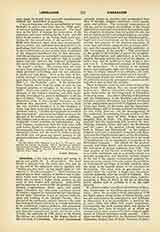

Levadoux, MICHAEL, one of the first band of Sulpicians who, owing to the distressed state of religion in France, went to the United States and founded St. Mary’s Seminary in Baltimore; b. at Clermont—Ferrand, in Auvergne, France, April 1, 1746; d. at Le-Puy-en-Velay, January 13, 1815. He entered the Sulpician Seminary at Clermont, October 30, 1769, where he studied theology, then went to the “Solitude”, or Sulpician novitiate, for one year. He was appointed, in 1774, director of the seminary at Limoges, where he remained till 1791. In consequence of the threatening aspect of affairs in France, Rev. J. A. Emery, Superior-General of the Sulpicians, deemed it prudent to found a house of their institute in some foreign country, and at the suggestion of Cardinal Dugnani, nuncio at Paris, the United States was chosen. Negotiations were opened with Bishop Carroll, but lately consecrated, and after some delay Rev. Francis C. Nagot, S.S., was named first director of the projected seminary at Baltimore. With him were, associated MM. Levadoux, Tessier, Garnier, and Montdesir, together with several seminarians. Rev. M. Delavau, Canon of St. Martin of Tours, and Chateaubriand joined the party, which sailed from St. Malo, April 8, 1791, and after a tempestuous and roundabout voyage reached Baltimore July 10. For one year M. Levadoux, as treasurer, assisted M. Nagot in organizing the Seminary of St. Mary’s, and was then sent by the latter to the Illinois mission, for which M. Emery had at first destined M. Chicosneau, deeming M. Levadoux a better administrator of temporal affairs. Empowered as vicar-general by Bishop Carroll, he took his departure for the west on January 15, 1792.
His missionary labors centerd around Cahokia and Kaskaskia. The registers of the latter place bear his signature from December, 1792, and he seems to have spent most of his time from 1793 to 1796 at Cahokia, though after M. Flaget left Vincennes in 1795 he visited that post also. Meanwhile as the health of M. Nagot, superior of the Sulpicians in the United States, was failing fast, he was desirous of having M. Levadoux near him at Baltimore, that he might be ready to succeed him in office; but Bishop Carroll was no less anxious to secure the services of the zealous missionary for Detroit. The bishop’s wishes prevailed, and M. Ievadoux became parish priest of St. Anne’s in 1796. It was he who performed the obsequies of Rev. F. X. Dufaux, S.S., missionary to the Hurons at the parish of the Assumption opposite Detroit, who died at his post September 10, 1796. After the demise of the latter, M. Levadoux had frequent occasion to minister to the spiritual wants of the Indians and of other scattered Catholics from Sandusky and Mackinaw to Fort Wayne. In 1801 M. Nagot recalled M. Levadoux to Baltimore, and in 1803 he received orders from M. Emery to return to France, where he was soon appointed superior of the Seminary of St. Flour in Auvergne, and remained there until the dispersion of the Sulpicians by Napoleon I, in 1811. When their institute was revived, in 1814, the Rev. M. Duclaux, successor of M. Emery, placed M. Levadoux at the head of the Seminary of Le-Puy-en-Velay. For years he had been suffering from the stone, which disease was the cause of his death in the following year. He bore the intense pains of his last illness with exemplary fortitude and resignation.
A.E. JONES

